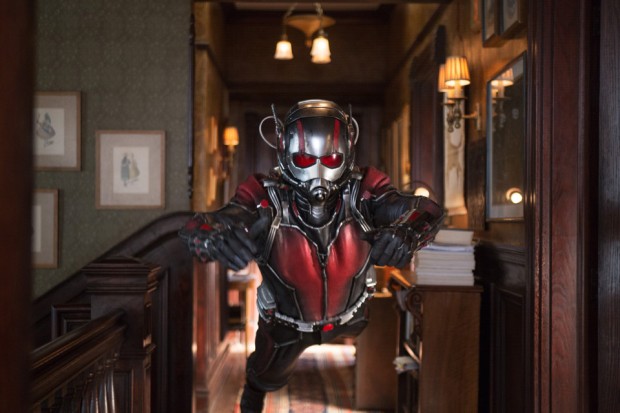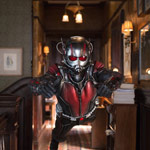
The visual-effects crew on Marvel’s Ant-Man scales the action both down and up for the tiny hero’s feature-film debut.
Marvel ventures into new territory with Ant-Man, a lighter action-adventure take on the superhero genre directed by Peyton Reed (Yes Man) and starring comedian Paul Rudd as the eponymous hero: a petty criminal who acquires a special suit that shrinks in size but provides incredible strength.
There were two big challenges on the film, according to Jake Morrison (The Avengers), Marvel Studios’ visual-effects supervisor who oversaw the work: How to do the incredible shrinking man with today’s tech, and how to pull off the army of ants in an equally believable way.
“We’ve done as much as we possibly could to push the art form,” says Morrison, who learned from such classics as Darby O’ Gill and the Little People, Fantastic Voyage, Inner Space and Honey I Shrunk the Kids.
“Here we have a man that shrinks and communicates with ants, which play a large character part in the movie,” he says. “My brief was to deliver photorealistic environments, show the audience what the macro world looks like but give us the same freedom of camera to do dynamic moves and really bring the audience in with a modern cutting pattern without any of the limitations that you would’ve had before.”
All of which jibes with the original comic-book character, who was created as Hank Pym in the January 1962 issue of Tales to Astonish. The character took on the Ant-Man identity a few issues later and played a key role in the early days of the Marvel Universe — he was, for example, a founding member of The Avengers in 1963. But the character was never a big hit, quickly taking on new powers and identities as Giant-Man before handing off the mantle of Ant-Man to various other incarnations in the decades since.
In the Suit
The Ant-Man suit is reminiscent of an old motorcycle suit with a diver’s helmet on top. They built a real version of the suit, which Rudd wears throughout the movie with a CG helmet.
For CG applications for the suit, every time there is walking, gesturing, a standing punch, they used motion-capture, building up a library with Rudd and his stunt-double.
For instance, when the suit gives him extra power, more acrobatic action beyond the realm of a normal person, they used animation. The edict was to animate the leap or summersault and then to seamlessly blend that with the mo-cap for the landing.
Meanwhile, they created three dedicated departments to handle the unique environments. “This is where we tried to reinvent the wheel,” says Morrison. “We pushed hard for production to create what was called a macro-unit. This was a dedicated art department designed to make macro sets to shoot with a camera. If there was a moment, say, where you were in a normal-size set where the actors are sitting around and talking, and somewhere in that scene Ant-Man is going to run under a door or jump onto a table, we effectively had the art department create that chunk of set that Ant-Man was going to interact with, physically building that 1:1 but much more highly-detailed. If he falls through a floor piece at one point and bounces off a pipe, the floor piece and the pipe are real and we salvaged as much as possible.
“We would line up multiple 6-by-8-foot table top sets pieces on a stage and our dedicated DOP would light these macro sets with lighting that was similar to the main sets but with added texture and contrast. We also brought in a motion-control camera for multiple moves with and without SFX. We’d shoot the move that we needed for the macro shot, but the trouble with Ant-Man is that because he’s only an inch tall, the physical size of the lens was still too large. So in effect we shot Ant-Man aerials.”
Then another team came in with three still cameras and motion control heads and got in closer creating a method of tiling with macro lenses and exposure brackets, tweaking the focus bit by bit as they went along. Then a third team came in with a high-res prop scanner and scanned every surface so you had all the grooves and pits and paint flakes. “So effectively we harvested all this information so you had perfect motion picture reference that was art-directed with a great camera move if you wanted to use the aerials and you’ve got a kit to make it as physically-based and photoreal as you need.”
Tackling Thomas
This all came together, for example, in the action sequence involving Thomas the Tank Engine (performed by Double Negative supervised by Alex Wuttke). “We wanted that to feel every bit as epic as watching Tony Scott’s Unstoppable. We have sweeping camera moves as the train rushes toward us, but everything’s on a macro scale yet it’s all physically-based,” Morrison says.
Then we have the ants.
“The concern early on was that people are creeped out by ants,” Morrison says. Method Studios in Los Angeles (supervised by Greg Steele) worked on the ant animation, making them photoreal and definitely not creepy, each with identifiable characteristics and behavior.
The winged carpenter ants that carry Ant-Man, for example, function like Pegasus, so they were a special, anthropomorphic hybrid. Luma Pictures (supervised by Vince Cirelli) handled the swarming ants, orchestrating a slew of different shapes.
“Ant-Man looks very heroic riding his steed, like Harry Hamlin in the original Clash of the Titans,” Morrison says.










 Win a Funko X Lilo & Stitch Prize Pack!
Win a Funko X Lilo & Stitch Prize Pack! 
